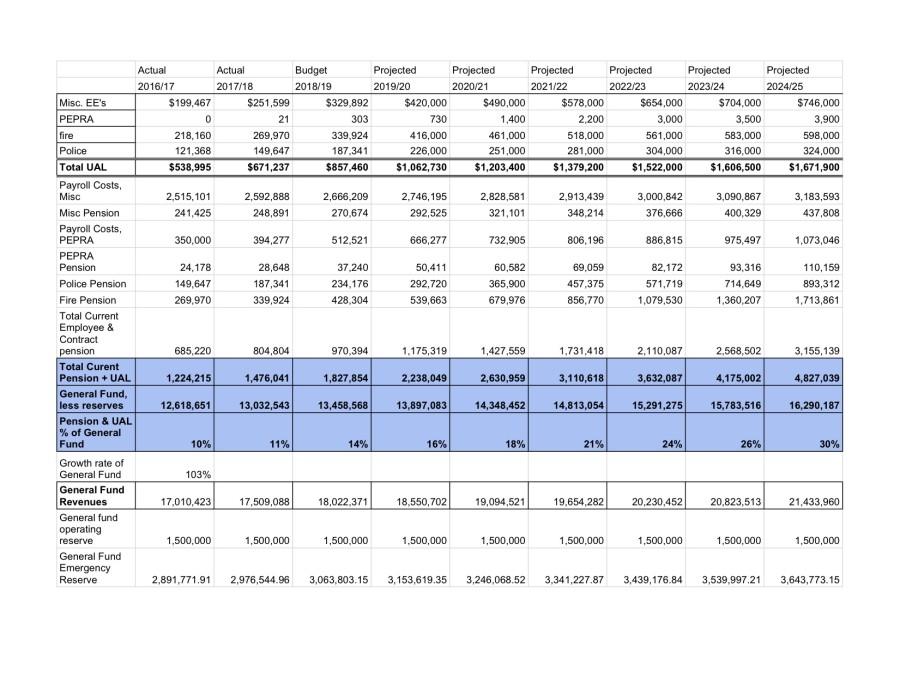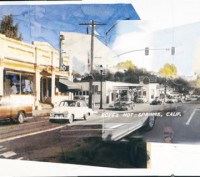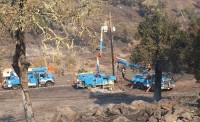By Larry Barnett | Sonoma Valley Sun
Over the next six to seven years pension costs to the City of Sonoma may balloon by well over 300%, rising from $1,467,041 in fiscal year 2017/18 to a projected $4,827,039 in 2024/25. As a percentage of available unrestricted General Fund revenues–forecasting a yearly increase of 103% but excluding operating and emergency reserves–by 2024/25 the city’s pension obligation could equal nearly 30%. Today’s pension obligation represents less than 10% of unrestricted General Fund revenues.
These sobering conclusions are the result of an analysis by the Sonoma Valley Sun of the pension obligations of the City of Sonoma to its various employees, past and present, based in part on data reported by CalPERS, the entity managing the city’s pension plan, and forecasts based on historical financial reports of the city (see Notes below). Notably, during the City Council’s recent goal-setting meeting, City Manager Capriola reportedly mentioned that any added revenues received from any increase in TOT (Hotel Tax) would eventually be needed to fund the city’s pension program.
The city’s pension program represents a long-term government obligation. Depending upon how employees are classified (including contracted employees such as Fire and Rescue Service, Sheriff’s Department and non-contract Miscellaneous) the full payment obligation can begin as early as after 25 years of government employment, Pension benefits accrue with each year of employment at a rate between 2% and 3% per year, depending upon job classification. Employees currently make a contribution to their pension plan, roughly equal to the amount contributed by the city, though in the past the city assumed the entire contribution amount.
An as example of how benefits accrue and are paid, a 30-year managerial employee earning a highest average salary of $175,000/yr. over five years would receive a pension benefit of roughly $105,000/yr. in perpetuity (2% times the number of years of government employment, times the highest five-year average salary).
Since the passage of a California pension reform act in 2012 (PEPRA), the city provides a second-tier pension plan for employees that requires a higher contribution from employees and reduces benefits, but those who have been employed prior to the implementation of this second-tier plan will generally continue to receive the original plan payments from the city in perpetuity upon retirement.
 CalPERS
CalPERS
The city participates in the statewide CalPERS program (California Public Employee Retirement System), which pools funds from the participating government entities and invests those funds to generate profits that can be used for the payment of pensions. However, CalPERS recently altered their formula for a return on their investments; the lower interest rates being generated on government bonds and other conservative investment vehicles in which CalPERS invests has resulted in lower overall returns. To solve this problem, CalPERS has lowered its target return from 7.5% annually to 7%, and to compensate for that, increased the amount each participating entity must contribute to the pension program, effectively raising the cost of pensions for all cities in the program by 5%.
Given that Sonoma’s accumulated pension reserves are significantly less than what they should be, the City of Sonoma currently earns a “D” rating for its accrued pension funding, according to a CalPERS formula. This can have a negative impact on the city’s credit rating and its ability to issue bonds or borrow funds. Moreover, unresolved issues like past water-rate overcharges and Water Fund money transfers may negatively impact the future fiscal resources of the city.
Potential Impacts
Given this dire scenario, some options facing the City of Sonoma might include (1) offering early retirement programs to long-term employees, (2) sharply reducing the number of its employees, and/or (3) accelerating economic development that generates additional revenue. That last option carries its own uncertainty, however. Sonoma is a small town and unaccustomed to rapid or major economic growth; large hotel and other high-intensity commercial projects are subject to public objections, appeals or even voter elections. Moreover, given the size of the existing unfunded pension liability, it’s unlikely any development solutions can generate the volume of revenue needed to meet the city’s pension obligations within the next six years. Moreover, the region’s overall economy is subject to periodic highs and lows; financial projections become less accurate as a forecast becomes more distant.
Due to the properties of compounding interest, front-loading as much revenue as possible into its pension plan reserves could have the greatest positive impact on the city’s future pension obligations, potentially saving millions, but major revenue to inject into its pension plan is not an the horizon; the city is hard-pressed for cash. Despite community hopes for swimming pools, additional affordable housing, open space acquisition, assistance to non-profits, parking improvements and other major civic projects, unless Sonoma’s pension obligation problem is solved, it will dwarf everything.
We asked Stanley Cohen, a certified public accountant and former Mayor of Sonoma to review this analysis and comment upon it. “Financial projections based upon the Sonoma Valley Sun’s analysis of information from CalPERS,” Cohen stated, “have left me astounded to see our small village that had accumulated millions of reserves to be in the financial position it is in today. As Mayor,” he continued, “I opposed any money being given to non-profits until I was assured the city could meet its financial obligations. Based on these forecast calculations, the city will be forced in the future to have no employees or enact its own real estate taxes in order to meet its pension obligations. The most drastic outcome is bankruptcy.”
Notes on forecast assumptions
As with any financial forecasts, those contained in this report are based on underlying assumptions. The Unfunded Accrued Liability (UAL) Pension increases are based upon the Actuarial assumptions found in CalPERS’ reports. However, it is impossible to know the precise actuarial assumptions used by CalPERS as they are highly complex; we can reasonably assume some of their assumptions have to do with the population demographics of the retirees, the current fund balances for each retiree, the contractual defined benefit, expected returns and expected length of time over which those benefits will be paid.
For miscellaneous and PEPRA employees (PEPRA covers those employees hired after the 2012 Pension Reform Act) the calculations are based upon the stated contribution rates found in the city’s budget and actuarial reports. Assumptions are based upon payroll data provided and the historical, annual growth of combined payroll and cost-of-living increases of 3%.
For Police and safety personnel, the current pension costs reflect the information in the previous audit; the budget and forecast are based upon the historical growth rate of change extrapolated to the fiscal year 2024/25. This rate of growth is supported by history, stated expectations provided by CalPERS in various press releases and circular letters to participating employers of reduced rate of return on investments.
These are also fairly conservative estimates as CalPERS last month announced that it was shortening the amortization period for pensions obligations from 30 years to 20 years, the effects of which will not be known on municipalities until later this year as the actuaries work through these calculations.










Long article , but holy smokes . Thanks
Just float another property tax increase. I pay for a hospital I will not use… the least I could do is pay for the retirement of what I am using.
There are no equivalent guaranteed pensions in the private sector. These benefits were obtained without taxpayer knowledge or input. It is outrageous that a city the size of Sonoma has been placed in such an unattainable position. Outsource all positions or declare bankruptcy like other municipalities.
Its time large portions of the Valley be annexed to the City to broaden the funding base for footing the City pension bill and other expenditures that benefit the Valley. As just a small example, the Plaza — maintained by City residents’ tax dollars — is enjoyed by the entire Valley, which also benefits from City fire protection. The ‘incentive’ to become a part of the City and share in the burden could be a threat of losing ALL the handouts to every tomdicknharry non-profit that serves the entire Valley & which City Council has so generously showered with City tax money for years if not decades. Past Council’s even lavishly promised $25,000 a year for ten years (i.e., a quarter of a million dollars) to a cockamamie Valley swimming pool scheme (to be built outside the City) that finally went belly-up because, well, it was a cockamamie scheme. It seems City Council never saw a request for a handout it could refuse, no matter how small or how grand. The threat of shutting off the money spigot could be enough to generate enough Valley-wide sentiment for annexation to create a City and community that reflects the fact that whether one lives in the City or the Valley, when it comes to facing 21st century social and financial challenges (and opportunities) ‘we’re all in this together.’
At present there is no quantifiable data that suggests an expansion of the city would produce a net increase in revenues vs. expenses. Undertaking such a study would be a major undertaking: defining borders, revenue sources, added expenses, cost of city services for deferred road maintenance and other infrastructure, pensions and salaries, government offices, and so forth, not to mention concerns about the UGB and protection of open space and agriculture. I suspect such an expansion would, as has been true of cities like Rohnert Park, a loser, monetarily. Existing housing does not generate sufficient property tax revenue, and new housing developments require an expansion of city services which over time offset construction fees and such one-time revenues. Proposition 13 has hobbled government since it does not include commercial properties, where the growth and value have been large. In short, your idea may have merit, but at this point it’s just an opinion not backed by any real data or projections whatsoever. It certainly will not solve the looming pension problem facing both the city and the county.
I am sure the County would love to get rid of the liabilities in the Springs, just the cost roads alone would bury any small municipality. The Springs really needs it’s own road improvement district, with taxes that currently go to the county being kept in the springs. Finally, if the city is not being well managed at its current scale, with this last two years has showing more than one financial calamity lurking with more shoes likely to drop, why would anyone think it would be better managed by taking on so much more.
It only makes sense to me, that if there is a core urban area, that it be administered as the unit it is. The political lines are artificial, the population taking up the same space is not. Good reasons to lump the core south valley urban area, from Agua Caliente to 8th Street east and the Lovall valley subdivisions to Schellville: all citizens would be enfranchised and have more of a direct say in how the area is administered; demographic inequities coild be addressed and Latino and working class residents better represented; citizenry and inclusion would be emphasized over residents as taxpayers; for revenue, including the 8th East business area would bring in $ and give a level of control over currently untaxed wine sales. What people prefer here is in many ways a lumper and splitter thing. I am for lumping the whole urbanized lower valley into one polity. I think the benefits outweigh the costs.
Another thought, smaller administrative units lead to a Balkanization-type paralysis where there are more arbitrary checks than unified balances. In Balkanization, each unit has to provide and pay for the same services required by all in the same overall region. People live in the lower valley here as a unified population whole, but are Balkanized into regions: business corridor, ag areas, the super well-to-do but less represented, unincorporated East Side; the well-to-do, well-represented city, and the not well-to-do, not well-represented Springs (this is not a complete demographic accounting). Those in the unincorporated county seem to exist OK with massively reduced levels of service and representation as compared to the city. Unincorporated residents can only gain by joining a polity that would give them more direct representation and likely more services than they get now, while current city residents can only lose by incorporating an “East Germany” with lots of needs and less wealth.
Low income residents are already displaced from Sonoma, and getting displaced daily from Springs by regional high COL. I see inclusion of adjacent valley areas as primarily a class and equity issue, one where interests are going to fight to not have to include the less well off, with a host of other proxy arguments. This is what was seen in Marin with major push-back against high density housing along transit lines.
Yet, like East Germany, these are our own people, right?
We can expect to see city residents defend their interests and their boundary. The moat, or current city boundary (of a pitiful two square miles, to have to pay for all a city’s services), that makes for classic Balkanization, has made Sonoma into a very attractive exclusive place wherein prices have been run up like crazy. The proscribed boundary and small, quaint-appearing polity are what is attractive to high income buyers.
A larger polity to bring in the local East Germany is the perfect way to start leveling the playing field, but it may too late for that, as enough new wealth is here now to “protect” the current city resident’s interests. Protectors come in diff shapes and sizes, for diff reasons; seeing who has what interests will make issues more transparent.
Life tends to adapt at higher levels of organization, human systems have moved that way as well. More modern organizational levels are global. Our common troubles need to be solved at the level of the whole. On the other hand, there has been a globalization backlash bc elites have run off with all the resources. More local focus and problem-solving gives people more of a say and maybe more lee-way to act adaptively. However, localities like Sonoma seem to be headed for exclusive Carmel-ization rather than with more inclusive, progressive adaptation policies.
Finally, expanding a political boundary is not necessarily “growth” or “sprawl”; it is mostly including what is already there. Some open properties will change status; zoning laws will be important to keep a tight rein on.
I see the one of main issues in Sonoma here as interest-based protectionism of a Balkanized unit, and of have-nots trying to get in to get some better representation. Locals are also trying to fight back against developer speculation that intensifies uses and brings more rats into the small Sonoma cage, all the while making it into a wine Disneyland. Maybe a town doesn’t want to be wine Disneyland…
I’m curious how and why it seems I am in some ways reaching a similar place as some local developers, even though I don’t share their values. I feel an exclusive-type pushback for wanting a larger local pie. This is in the spirit of inquiry here, genuinely curious, when odd contradictions pop up, it piques my interest. For sophisticated local players like Larry, this is not mere NIMBYism. It’s really a dynamic conversation about salient Bay Area and California issues.
My program overall would be to take disparate pieces of the pie, unify them into one lower valley unit and then divide that pie into smaller pieces for more people, rather than a growth program where more resources get used on individual multi- million dollar kingdoms within a bigger administrative unit. If it is not possible, through zoning, to prevent too much market rate speculation in an expanded polity, then the only option may be to fight speculator money that results in too much luxury housing. It’s called planning and zoning, and maybe applying principles of social and environmental justice, and not letting the market decide the character of a place, over much-needed triple bottom line sustainability.
All interesting thoughts for the inquiring mind.
Fred’s ideas are too philosophical; he ignores the practical, social and political realities. Expansion of the city as he describes requires the initiation and approval of property owners, and cannot be unilaterally imposed by the city. Annexation is complicated, uncertain, and time-consuming. Moreover his idea is based on unsubstantiated assumptions, financial and otherwise. It’s a good example reflexive utopian thinking that’s not reality based. What he describes ain’t gonna happen, and spending time fantasizing about it is a waste of time, if entertaining.
Posted a reply x 2m and had another comment deleted in Facebook. Am I being censored?
No.
Thank you Larry for this important information. I think perhaps it is time for the city manager to explore new more creative options for getting work done in this city without employees. An organized volunteer army of sonoma citizens could easily pick up some slack. Let’s get her done ! Pensions have to be honored but perhaps they could be tailored more to suit reality..